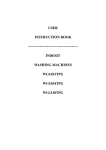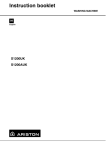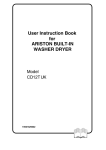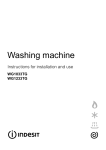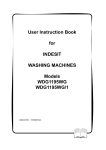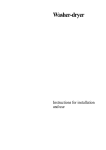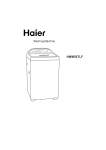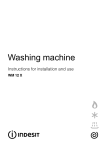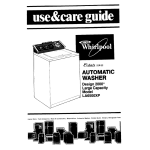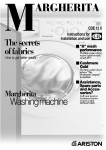Download Ariston Washer Owner`s manual
Transcript
User Instruction Book for ARISTON BUILT-IN WASHING MACHINE Model LB6T LB6TX Margherita Thank you for choosing an Ariston product. This washer is reliable and easy to use. We suggest you read your owner's manual carefully. This will help you become familiar with your washer and its functions in order to obtain years of trouble free performance. Saves while it washes The double action wash penetrates so deeply that at just 60°C you obtain the same results you would normally obtain at 90°C with a traditional washer. Controlled consumption The machine automatically adjusts the amount of water used in the wash to the size of the load, giving optimum use of water, energy and detergent. Double-action wash Clothes are soaked in water and detergent, water then “rains” steadily through the clothes. Safety, a good habit to get into CAUTION Please read the instructions in this handbook carefully, as they contain important information about safe installation, operating and servicing. This washer is manufactured in compliance with international safety regulations designed to safeguard the consumer. 10. Beware that during the wash cycle the door glass can become hot. Children should not be left unsupervised whilst the appliance is in operation. During operation the door is locked at all times. On each stop position the door will release after an approximate 3 minute time delay. Do not attempt to open the door before this time otherwise damage may occur to the door release mechanism. 1. This appliance is designed to be used indoors and under no circumstances should it be installed outside. 2. This appliance should only be used in a domestic environment by a responsible person to wash household laundry according to the instructions. 3. Under no circumstances should children be allowed to operate or tamper with this product. 4. Beware, this appliance is heavy, do not attempt to move it, unless you are able to do so. 5. Before the introduction of a new wash load into the machine, please ensure all previous items have been removed. 6. For electrical safety do not attempt to operate this machine with wet hands or feet. 7. Do not operate this appliance connected to an extension lead. If a longer supply cable is required this must be replaced with one of the same specifications in compliance with the current electrical regulations.This operation should be carried out by a qualified person. 8. After putting in the detergent, ensure the soap drawer is fully closed before operating the appliance. Only automatic detergent should be used, or too many suds will be produced and damage may occur to internal parts. 9. Do not pull the supply cable to disconnect the plug from the wall socket. To maintain the EFFICIENCY and SAFETY of this appliance, we recommend: • call only the Service Centers authorized by the • 13 manufacturer always use original Spare Parts GB Overview E D H F B C The dials are flush with the facia of the machine To pull them I L G A D. Rinse Hold button out, press the middle of the dial in gently. A. Programme selector Use this dial to select one of the 15 wash programmes available for all your laundry requirements (see programme table on page 17). The programme selected is displayed in window L. Remember that this dial should be turned in a clockwise direction and only when the machine is off. B. Temperature selector This function interrupts the cycle so that the laundry is left soaking in water before the spin cycle.This function is extremely useful because it stops delicate or synthetic fabrics from creasing (for example when one has to wait several hours before removing the laundry load). It should be used only with the programmes for synthetic fabrics and woollens. IMPORTANT: Before opening the door, drain away the water by setting knob A on "drain", the number 15 must appear on the window L. To carry out the spin cycle, simply press D. E. Spin Cancel button Use this dial to set the wash temperature shown in the programme table (page 17). You may reduce the recommended wash temperature of the programme you have selected or run a cold wash (symbol ). Use this button to exclude the spin cycle. This function should be used for items that are difficult to iron. F. Extra Economy button C. Detergent dispenser The detergent dispenser has three compartments marked 1, 2 and 3: 1 prewash detergent 2 wash detergent 3 fabric softener. GB Reduces water consumption during the rinse cycles. We recommend that you use this function only with small laundry loads, dosing the detergent proportionally. 1 2 G. ON-OFF button 3 This button turns your appliance ON/OFF. Press button G to turn on the washer and depress button G to turn off the washer. 14 H. Door Lock indicator light This shows that the door is locked. Wait at least three minutes after the light turns off (about 3 minutes after the end of the wash programme) before opening the door. I. ON/OFF Indicator light When this is lit, the machine is on. L. Programme display The programmes selected with dial A appear on this display; while the programme is running the various stages of the programme are displayed. Using your washer Preparing your laundry.... Divide your laundry by fabric and colour fastness. Wash white and coloured items separately. Remember to empty pockets, removing especially those small items like coins, paper, pins and badges that might jam the pump. Fasten or remove loose buttons and fasten zippers. Turn shirts inside out for better results. Compartment 1 Prewash cycle detergent (powder) Compartment 2 Wash cycle detergent (powder or liquid) Compartment 3 Fabric softner 1 2 3 Check wash labels Garments and laundry generally have wash instruction labels (which tell you if they shloud be dry-cleaned, hand washed or machine washed) showing the wash temperature, how to iron etc. Important: fabrics should only be machine washed if their labels show the appropriate symbol (see table 1 page16). Alternate small and large items when loading your washer For best results, we recommend you alternate small and large items when you load your washer remember to spread them out; never wash large loads of terry cloth items. Detergents and fabric softener Never fill compartment 3 above the grid. Use compartment 2 for liquid detergent, filling the compartment just before you start the washer. Remember that liquid detergent is ideal for wash cycles with temperatures up to 60°C and for the programmes with no prewash cycle. Dispensers for liquid and powder detergents which are placed inside the drum of the washer, are sold on the market. To improve the effectiveness of the washing cycle, we recommend that you insert a detergent dispenser in the drum before loading the laundry. Do not use hand washing detergents since these produce very heavy suds. When using cold wash cycles, remember to reduce the detergent dosage. Open detergent dispenser C by pulling it outwards. Fill with detergent and conditioner using the quantities indicated by the manufacturer on the packet according to the load you are washing, the water hardness and how soiled your laundry is. As you become more familiar with your washer, you will regulate the quantities according to your own personal experience. 15 GB 1. Understanding the labels Strong action Wash at 95°C Wash Wash at 60°C Wash at 40°C Wash at 30°C Iron at max 100°C Not ironable Hand wash Delicate action cl Bleaching Do not only in bleach cold water Bleachin Hot iron at max 200°C Ironing A Dry cleaning High Temperat Drying Medium hot ironing at max 150°C F P Dry clean with any solvent Dry clean only with, perchloride benzine av., pure alcohol, R111 and R113 Dry clean with av. benzine, pure alcohol and R113 Do not dry clean Machine dryable Do not Spread to machine dry dry Hang to dry Dry on clothes Starting up your washer Run the first wash without laundry using programme 2 at 90°C. Load your laundry in the washer, add the detergent and fabric softener (see pages 15) and remember to: - shut the door properly - plug the washer in at the mains - turn on the water supply - check that button G is not pressed in (position O) Selecting the programme For help on selecting the cycles, consult the table on page 17. Turn the knob A until the number of the desired cycle is displayed in the window L. Set the temperature on dial B and, if necessary, press function button (D E, F); set ON/OFF button G to position I (ON). At the end of the wash cycle... Wait for indicator light H to turn off (about three minutes), switch off the washer by setting the ON/OFF button G to O (OFF); you can now open the door. Once you have removed your clean laundry from the washer, remember to leave the door open or at least ajar (this will prevent the formation of an unpleasant odour) and shut off the water supply. GB 16 Not washable in water Selecting the programmes The description of the wash programme by type of fabric is shown on the detergent dispenser. Type of Fabric & How Dirty Cycle Knob Temp. Knob Pre-wash Detergent Wash Detergent Softener Description of Wash Cycle Extremely dirty whites (sheets, tablecloths, etc.) 1 MAX ◆ ◆ ◆ Warm prewash, wash at 90°C, rinses, intermediate and final spins. Very dirty whites (sheets, tablecloths, etc.) 2 MAX ◆ ◆ Wash at 90°C, rinses, intermediate and final spins. Very dirty heavy whites and colours 2 60°C ◆ ◆ Wash at 60°C, rinses, intermediate and final spins. Very dirty heavy whites and colours. 2 40°C ◆ ◆ Wash at 40°C, rinses, intermediate and final spins. Fairly dirty heavy whites and colours (coloured underwear, house coats, etc.) 3 60°C ◆ ◆ Wash at 60°C, rinses, intermediate and final spins. Whites and delicate colours that are not very dirty. 3 40°C ◆ ◆ Wash at 40°C, rinses, intermediate and final spins. Whites and delicate colours that are not very dirty (shirts, T-shirts, etc.) 4 40°C ◆ ◆ Wash at 40°C, rinses, intermediate and final spins. Rinses 5 ◆ Rinses with automatic softener dispensing, intermediate and final spins. Softener 6 ◆ Rinses with automatic softener dispensing, intermediate and final spins. Spin 7 HEAVY FABRICS Drain and final spin. SYNTHETICS Very dirty heavy synthetic colours (underwear for infants, etc.). 8 60°C ◆ ◆ Wash at 60°C, rinses, wrinkle-guard or delicate spin. Very dirty synthetic colours. 8 50°C ◆ ◆ Wash at 50°C, rinses, wrinkle-guard or delicate spin. Very dirty, delicate synthetic colours. 8 40°C ◆ ◆ Wash at 40°C, rinses, wrinkle-guard or delicate spin. Fairly dirty delicate synthetic colours. 9 50°C ◆ ◆ Wash at 50°C, rinses, wrinkle-guard or delicate spin. Not very dirty delicate synthetic colours (all types of underwear). 10 40°C ◆ ◆ Wash at 40°C, rinses, wrinkle-guard or delicate spin. Rinses 12 ◆ Rinse with automatic softener dispensing, wrinkle-guard or delicate spin. Softener 13 ◆ Rinse with automatic softener dispensing, wrinkle-guard or delicate spin. Spin 14 Drain and delicate spin. DELICATES ◆ Wash at 40°C, rinses, wrinkle-guard or delicate spin. 12 ◆ Rinse with automatic softener dispensing, wrinkle-guard or delicate spin. Softener 13 ◆ Rinse with automatic softener dispensing, wrinkle-guard or delicate spin. Spin 14 Drain and delicate spin. Drain 15 Drain without spin. Wool (machine washable) 11 Rinses 40°C ◆ 17 GB Washing tips Stain removal What not to wash in your appliance? The most common stains will disappear during the wash. If they are particularly stubborn, soak the garment in water and rub a little detergent onto the stain before putting it in the washer. Greasy marks (especially old ones) need treating with a stainremover. Be careful not to mark the fabric with remover. - Torn, frayed or unhemmed items; in order to wash items of this kind, wrap them in a linen bag to prevent them from tearing during the wash. - Dark coloured items with white items. Dark items should be washed separately. Curtains Pre-treatment for awkward stains - Ink: ball point/felt tip; Put a few drops of nail varnish remover or surgical spirit onto a piece of cotton wool and dab the stain. Wash at 90°C (NB. This is only suitable for colourfast cottons) - Tar and oil; Scrape off any thick tar or oil on the surface. Soften the remainder with margarine or butter and wipe away with a clean cloth. Treat any residual stain with turpentine, then wash according to the fabric - Wax; Scrape off, then put the stained garment between two pieces of blotting paper and press with a hot iron. Dab the stain immediately with cotton wool dipped in turpentine - Chewing gum; Apply nail varnish remover to the gum, then remove it carefully - Lipstick; Pretreat with a liquid detergent using the dosing ball, rub vigorously and rinse before washing - Grass; Soak in a warm washing solution using a biological washing product, then wash according to the fabric. Alternatively, saturate the stain with white methylated spirit. Rinse and wash normally - Paint: Water based latex, acrylic and school paints, emulsion paints; Treat stains while still wet. Rinse thoroughly under running water to flush out the paint, then wash according to the fabric. Oil based paint/varnish; Sponge with white spirit or paint brush cleaner before washing in the normal way. Do not exceed the recommended weights shown in the table For best washing results, do not exceed the recommended weights shown in the table; the weights shown refer to dry laundry. Maximum dry laundry load heavy fabrics maximum 5 kg delicate fabrics maximum 2 kg pure new wool maximum 1 kg mixed loads maximum 2,5 kg GB How heavy is your laundry? 1 sheet 400-500 g 1 pillow case 150-200 g 1 table cloth 400-500 g 1 bathrobe 900-1200 g 1 bathroom towel150-250 g 18 Curtains tend to crease badly. Try this washing hint to prevent creases: fold the curtains carefully and place in a pillow case or loose mesh bag; wash separately ensuring that the weight is no more than a half wash load. Quilts, tennis shoes and wind-cheaters Contrary to common belief, goose or duck down quilts and wind-cheaters, can in fact be machine washed, provided the instructions shown on the label are followed carefully. Remember however to load no more than 2-3 kg of laundry and to repeat the rinse cycle once or twice following with a gentle spin. In the case of tennis shoes, wipe off mud and then machine wash with denims or heavy fabrics (but not white fabrics). Energy saving hints - Try to wash complete laundry loads: this saves unnecessary consumption of water and energy. - Select the right programme for your laundry: this will obviously depend on the type of fabric and how soiled your laundry is; we recommend the use of programmes without prewash which will save you time, water and energy. The prewash cycle should in fact be used only for heavily soiled, cotton fabrics. - Set the right temperature: use temperatures above 60°C only for very stubborn dirt but remember that modern detergents are very efficient even at low temperatures. - Use the correct quantities of detergent: do not use too much detergent; remember that not only will this make rinsing more difficult but also pollutes the enviroment. - Use the economy buttons: when washing small laundry loads use the Economy button if available on your washer and reduce the detergent quantity. - Your washer features automatic consumption control, this means that you can wash laundry loads from 1 - 5 kg with considerable savings. Your washer will use just the right amount of water and electricity. All you need to do is dose the detergent. - Fabric softeners: always use a softener; not only do these perfume and soften your laundry, they also make it easy to iron, saving you time. General maintenance After every wash When moving house Leave the door open and wipe the door gasket dry after each wash so that damp or odours do not form. When you move, all you need to do is secure the inside of the machine with the transit screws (supplied with the packaging of the machine) so that it will not be damaged. Remove the plug Before cleaning or servicing always remove the plug from the socket. This is for safety reasons. Cleaning and special servicing Hose No solvents or abrasive substance You do not need solvents or abrasive substances to clean the outside of the washer and the rubber parts. Just use a cloth, warm water and soap. Detergent dispenser drawer Inspecting the drain pump 1 This can be removed and cleaned. Just pull it towards you, as shown in the diagram, and leave it under running water for a few minutes. Check the hose once a year. It should be replaced if any signs of splitting or damage can be seen. The machine is under a lot of strain while operating and this may cause a cracked hose to split open suddenly. 2 Unplug the machine when you go away It’s best to unplug the machine when you go away, turn off the water supply and leave the machine door open or ajar. The drum and rubber door lining will dry and no unpleasant odours will form inside. Your washer is equipped with a self-cleaning pump, and, therefore, does not require maintenance or cleaning. However, certain types of objects might find their way into the pump (e.g. buttons, coins, etc.). Since they are too large to be expelled through the drain pipe, they will be trapped in the “antechamber” of the pump, which is accessible from the front of the pump itself. To gain access to this compartment, simply remove the finishing strip on the base of the cabinet (Fig. 1), remove the Z screw (Fig. 2) with a screwdriver and take off the cover of the pump. Then carefully inspect the interior. Caution: Before removing the cover, make sure that the wash cycle has finished completely. Then, turn off the machine by, switching the ON/OFF button G to the O setting. It is normal for a small quantity of water to escape after the cover has been removed. When you replace the cover, make sure that it is closed tightly. 19 GB Removing limescale Z Water contains increasing amounts of limescale because of pollution. If you live in a hard water area in addition to using water-softener in each wash, it is a good idea to put the machine through a cycle without laundry or detergent, just using limescale remover. Fig. 1 Fig. 2 Trouble shooting If the machine does not seem to be working properly before calling the service engineer there are a number of things you can check. Perhaps you have forgotten to push in a button or you are not using the machine properly. Machine won't start Make sure: the appliance is plugged to the mains socket; you have electricity in your home, the door is firmly shut, the ON/OFF button G is on I, the programming cycle knob, in washer which have one, is on O, the programme is properly set and the mains water tap is open. Machine won't fill Make sure: the internal oscillating unit was released correctly at the time of installation (see installation instructions); the washer is levelled correctly or too tightly fitted between furniture units and the wall. Your washer is leaking. Make sure: the ring nut of the supply pipe is firmly tightened; the detergent dispenser is not plugged and the drainage pipe is firmly fixed. Excessive formation of suds. Make sure: the water tap is open and connected correctly to the hose; the water mains has not been cut off and that water pressure is sufficient; also check the hose for kinks. Water is pumping in and out all the time Make sure: there are no kinks in the drain pipe and that it is at least at a height greater than 60 cm; the pipe mouth is not below water level and that the wall drain has no air outlet. If the problems continue even after you have checked these points, shut the water tap and turn off your machine. Problems with pumping out water or spinning Make sure: the programme selected has a draining cycle; the non creasing "hydropstop" button, on washer which have one, has not been pressed accidentally; the drainage pump is not jammed; the drain pipe is bent; the drainage piping is plugged; any drainage pipe extensions are properly connected and do not prevent water flow. GB Lots of vibration during the spin 20 Make sure: the type of detergent you have used - is it suitable for an automati washer - have you used too much detergent? If despite all this your washer is still not running properly, call your local Authorized Service Centre providing the following information: - fault model code (Mod. ....) and serial number (S/N ....) indicated on the plate located on the bottom part of the machine. Never use the services of an unauthorised servicing technician and insist on the use of original spare parts. Installation Transit packing After removing the packing, check the appliance for damage. If you have any doubts do not use the washer and call a qualified technician. Keep the packaging components (plastic bags, polyester foam, nails etc.) out of the reach of children since they could be dangerous. The interior of the washer, has an oscillating unit which is fixed on the back by 3 screws during transport (figure 3). Before starting up the washer, release the unit, by unscrewing the 3 screws. Seal the screw holes with the plastic plugs supplied with the appliance. A Fig. 5 Fig. 6 Connecting the drain pipe Fig. 3 Fig. 4 Levelling The machine must be level in order to operate properly, To level the machine, simply regulate the adjustable feet (fig. 4); the angle of inclination (measured on the top of the machine) must not exceed 2 degrees. If the washer is installed on a carpeted floor, check that there is sufficient ventilation space between the floor and the bottom of the machine. Connect the drain hose to a drain (with a minimum inner diameter of 4 cm), avoiding excessive crimping or the formation of elbows. It is important that the hose be positioned at a height greater than 60 cm. If this is not the case, the hose must be fastened to the hook located on the top part of the back of the machine (fig. 7). If a drain pipe coming from the wall is used to connect the hose, have a qualified plumber/technician check to make sure that it functions properly. If your home is on the top of an apartment building or condominium, the drain may be subject to a siphoning effect which results in the machine filling and draining continuously. To eliminate this inconvenience, special valves are available on the market which can be fitted to the drain hose. Water supply Make sure that the water pressure is between the maximum and minimum values indicated on the data plate located on the back of the washer. Connect the inlet hose to a cold water tap with a 3/4 gas threaded opening, and fit the filter and the rubber gasket supplied with the washer. Check that it is tightly screwed to the tap (see fig. 5). If the water piping is new or has not been udes for a long time, before making the connection, let the water run until it is clear and free from impurities. This step is necessary to ensure that the incoming water does not clog and possibly damage the washer. Connect the other end of the pipe to the appliance, at the top on the right, by the water connection (see fig. 6). Fig. 7 Electrical connection Before connecting the appliance to the mains, check the following: 1) your mains socket must support then maximum power load of the appliance, which is shown on the data plate; in addition the socket must comply with legal regulations; 2) the supply voltage must correspond to the values shown on the data plate; 3) the socket must be suitable for the plug of the appliance; replace the socket or the plug but do not use an adapter; 4) home electrical systems must be earthed, in compliance with ministerial directives. Should the electric system of your home not comply with these directives, the manufacturer declines any liability for any possible consequences. 21 GB Mounting the wooden panel onto the door and inserting the machine into cabinets: Door Mounting Accessories (Fig. 8-9-10-11-12-13) In the case where the machine must be shipped for final installation after the wooden panel has been mounted, we suggest leaving it in its original packaging. The packaging was designed to make it possible to mount the wooden panel onto the machine without removing it completely (see figures below). The wooden panel that covers the face of the machine must not be less than 18 mm in thickness and can be hinged on either the right or left. For the sake of practicality when using the machine, we recommend that the panel be hinged on the same side as the door for the machine itself - the left. Fig. 9 Fig. 8 N° 1 Magnet cheria lavabian machine washing à laver machine chine as waschm N° 2 Hinges N° 2 Hinge Supports Fig. 10 N° 1 Magnet plate Fig. 11 6 5 4 3 2 1 ta Lato por Door side te Cote por te Tur sei B A N° 1 Rubber plug Fig. 12 Fig. 13 No. 6 type A self-threading screws, l =13 mm No. 2 type F self-threading screws, l =9 mm No. 2 type B metric, countersunk screws, l =25; for fastening the magnet plate to the cabinet No. 4 type C metric screws, l =15 mm; for mounting the hinge supports to the cabinet No. 4 type D metric screws, l =7 mm; for mounting the hinges on the supports D C N° 2 Base molding guide Mounting the Parts onto the Face of the Machine cheria lavabian machine washing à laver ne hi ac m aschine waschm · Mount the hinge supports onto the face of the machine, 6 5 4 3 2 1 positioning the hole indicated by the arrow in Fig. 8 towards the inside of the face and using the type C screws. · Mount the magnetic plate on the opposite side, at the top, using the two type B screws. ta Lato por Door side te Cote pore Tur seit E GB F 22 Using the Drilling Template · Place the top edge of the drilling template so that it is flush with the top edge of the panel, making sure that it is positioned correctly and centered in the horizontal direction (use the dotted lines on the edges to line the template up). Mark the points on the panel for the four holes. · Use an appropriately sized router to mill the holes for the two hinges, the rubber plug and the magnet. · To adjust the position of the wooden panel in both the vertical and horizontal directions, use the C and D screws, as shown in fig. 15. · If the machine is installed at the end of a set of modular cabinets, mount either one or both of the guides for the base molding (as shown in fig. 16) with the type F screws. Adjust them for depth based on the position of the base molding, and, if necessary, fasten the base to the guides. Mounding the Parts onto the Wooden Panel (Door) 598 D 57 min0 820 820 ÷ 870 · Insert the hinges into the holes (the movable part of the hinge must be positioned facing away from the panel) and fasten them with the 4 type A screws. · Insert the magnet into the top hole on the opposite side of the hinges and fasten it with the two type B screws. · Insert the rubber plug into the bottom hole. The panel is now ready to be mounted onto the machine. C 600 min 537 Fig. 14 C Fig. 15 Mounting the Panel into the machine Insert the nib of the hinge (indicated by the arrow in fig. 9) into the hole for the hinge and push the panel towards the front of the machine. Fasten the two hinges with the type D screws. 90 m m Inserting the machine into the Cabinet · Push the machine into the opening, aligning it with the cabinets (fig. 14). · Regulate the adjustable feet to raise the machine to the appropriate height. Fig. 16 Technical characteristics m odel LB 6 T -LB 6 TX dim ensions w idth cm 59,8 heightcm 82 depth cm 53,7 Control programs in compliance with IEC regulation 456: Cotton program: Turn knob A to the "program 2"setting; Turn knob B to the "60°C" setting. capacity 1 -5 Kg electrical voltage 220/230 Volt50 Hz connections m axim um absorbed pow er2300 W w ater m axim um pressure 1 M Pa (10 bar) connections m inim um pressure 0,05 M Pa (0,5 bar) drum capacity 42 litres spinning speed up to 600 rpm This appliance conform s w ith the follow ing E.E.C. directives: -73/23/EEC of19/02/73 (Low Voltage)and subsequentm odifications -89/336/EEC of03/05/89 (Electrom agnetic Com patibility)and subsequentm odifications 23 GB












